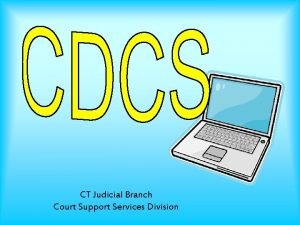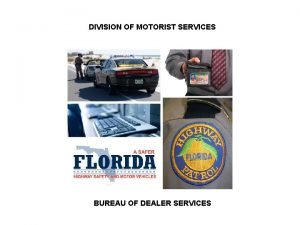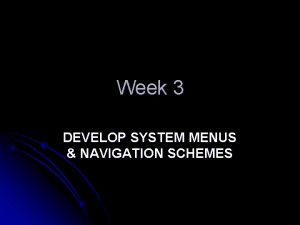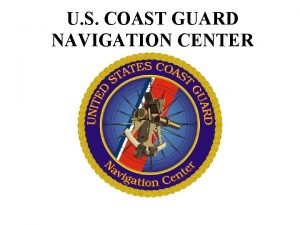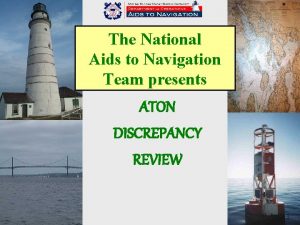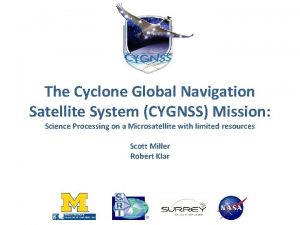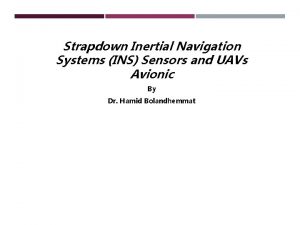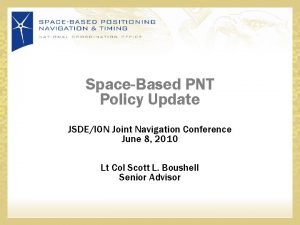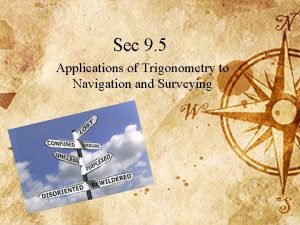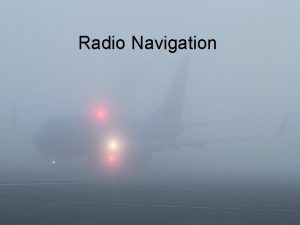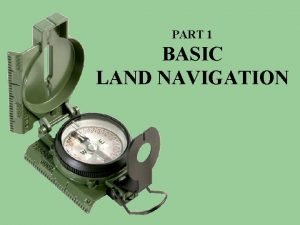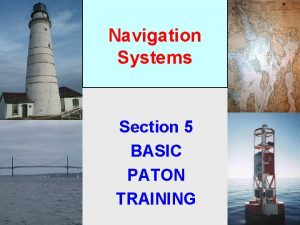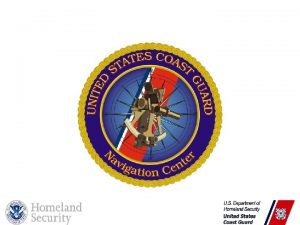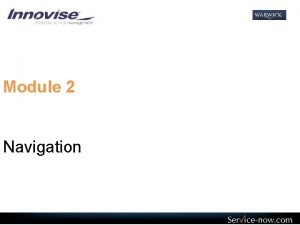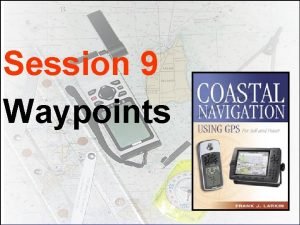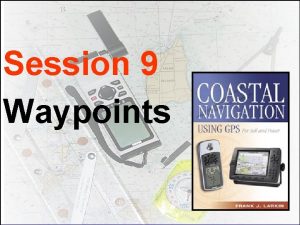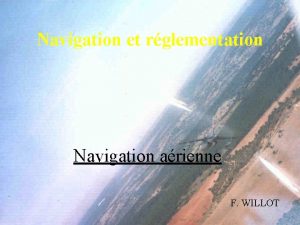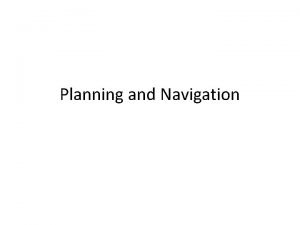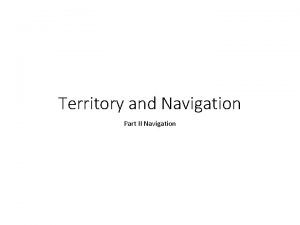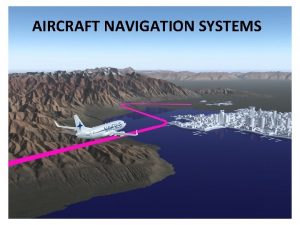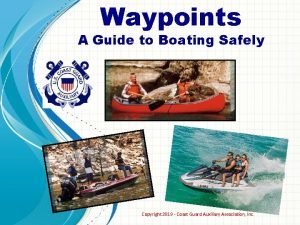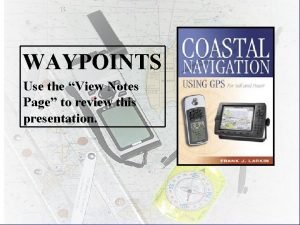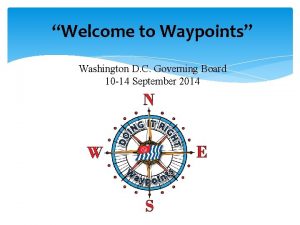Navigation Services Division Understanding Waypoints THE OFFICIAL NAME


















































































- Slides: 82

Navigation Services Division Understanding Waypoints

THE OFFICIAL NAME IS NAVISTAR GPS

NAVISTAR GPS NAVIgatonal System using Timing And Ranging Global Positioning System

GPS is a satellite navigation system developed by the. US Dept. of Defense (DOD)

GPS provides continuous, all-weather, threedimensional positioning information (position, speed and time)


GPS is used by aviators, mariners, surveyors, off-roaders, truck operators, bikers, hunters & fisherman

10 -12 meters 5 -10 meters 12 -14 meters

GPS positions are not error free!


CEP = Circular Error Probable SEP = Spherical Error Probable

24 hours 5/2/2000 24 hours 5/1/2000 Without Selective Availability 95 % of the time within 45 meters within 6. 3 meters or 148 Feet or 21 Feet

Datum is a chart coordinate reference system.

A datum is shown on every chart Your GPS receiver must be adjusted to the datum printed on the nautical chart that you are using.

Selecting the correct datum • WGS-84 is the standard, NAD-27 is common. • Becomes more important as local datum become increasingly offset from WGS-84. • Shown on the General Information Blocks of most charts/maps.

Horizontal Datum WGS 1984

GPS Setups • You should have already selected and set up: – A true or magnetic direction, – Nautical miles, – The 24 hour clock

GPS Receiver Display What is it telling you?

Basic GPS Receiver Functions u. Provide details of your GPS system’s status. u. Shows the satellite positions and signal quality.

GPS Satellite Status Fix Status/EPE Three Polar plot shows where Dimensional satellites are located. Battery status Navigation graph Capability Bar graphs give an immediate indication of signal strength

Always validate satellite performance before using your GPS set for navigation.

What GPS Position Page Direction bar at can problems This is not a top of screen. compass reading! you detect Course and Speed from this Mileage and Altitude screen? Position Time

Basic GPS Receiver Functions • Continuously determines your position. • Displays the time. • Shows a heading and SOG—speed over the ground--on the present leg. • Show a BRG--bearing and a DTG-distance to go—to the next selected waypoint.

Basic GPS Receiver Functions • Shows the distance you are off track XTE - cross-track error. • Shows TTG - time to goto waypoint. Uses SOG. • Estimates the time of arrival-ETA--at waypoint. Uses SOG and DTG.

Keyboard Orientation +/- Plus or Minus Key 0 -9 Numeric Keys A-Z Alphabetic Keys ENT Turns cursor on or off. Opens or confirms data entry. MENU Turns Menu Bar on or off. MOB Activate Man Overboard function. + Zoom In Smaller overview – more details. - Zoom Out – Larger overview – less details.

Keyboard Orientation O Cursor Key – multi-directional. GOTO Activates POP-UP window. Selects NAV MODE. Short cut to chart display. PLOT Selects PLOT MODE. WIN Toggles between selected windows. Returns system to manual operation. CLR Turns off Menu Bar. Turns off Cursor. Deletes data. PWR Turns unit on and off.

Trend is toward fewer keys. Ten Keys Hand-helds Seven Keys

1. Learn how to input waypoints. 2. Learn how to use waypoints.

A waypoint (WPT or WP ) is a designated location with geographic coordinates.

You need to learn how to: • • • Store present positions. Enter a position. Rename, edit, and copy waypoints. • Create and edit routes. • Delete waypoints and routes.

Entering Waypoints • Enter in name/icon. • Enter LAT/LON. • Enter message (not recommended) • Waypoint number. (Keep it simple) • Menu of waypoint options at bottom. • Bearing and Distance

A simple waypoint entry screen

Verifying your present position as a waypoint • Use a simple numbering system. WPT 4 • Do not place your position on top of the Aid. Risk of collision! • Validate every waypoint before using it as a permanent waypoint in a route. WPT 1 WPT 3 WPT 2

Waypointsare used extensively in GPS navigation: • As boundaries between voyage segments – LEGS. • To mark turning points, destinations and aids to navigation. • To mark hazards to navigation.

• GPS receivers enable waypoints to be entered and stored in various ways. • A sequence of waypoints can define a planned route. • Most GPS receivers store routes as well as waypoints

Waypoints are often used to define route segments – legs. – Insert waypoints at all turn points on your courses. – Establish some voyage waypoints close to (but not at) aids to navigation

Always pre-plot all waypoints on a nautical chart and measure the distance and bearing between waypoints. • Verify that the trip legs are planned in safe water. • Record the data on a Trip Log.

• Waypoints do not have to be located in the water--e. g. , locate a waypoint at a lighthouse to enable you to know where and when to look for it • Waypoints can be used to mark hazards to navigation--areas to avoid as well as areas to visit safely.

• Select waypoints that can be easily verified by other methods--visual fixes, soundings, radar, etc. NEVER rely on one means of navigation.

• It is important to check your chart before establishing. WPTs. • If the course crosses an island, the GPS receiver will direct you to navigate into this hazard. WPT 02 WPT 01

Why create a route? • Routes are lists of sequential waypoints. WP 4 • GPS can automatically advance you to the next waypoint. • Routes can be reversed to retrace your original track. • Routes keep you from wandering into danger and shorten distance traveled WP 1 WP 3 WP 2

WP 4 Editing Routes • GPS receivers should allow you to WPT 3 delete, move, or append waypoints. • In this case: WPT 2 has been deleted. WPT 3 has been moved. WPT 2 WPT 4 has been appended. WPT 3 WPT 2 WPT 1

GOTO Navigation • Used by any boat in open water to navigate to a single waypoint. • Useful functions: – – – Range and Bearing Speed of Approach Turn

, 0 30 NM 2 3. • The distance and direction to a waypoint. • Probably the most useful of all navigation functions. • Know your units: true vs. magnetic, statute vs. nautical ° Range and Bearing

Course To Steer • Course To Steer gets you back to the course line at a 45° intercept to try to keep you out of trouble Desired Course Line S T C ing Bear Third Reef

ROUTE Navigation WPT 2 • Used by boats under power when they have to stay in a channel or follow an exact course line • Useful functions: – Cross Track Error(XTE) – Course To Steer (CRS) – Time To Go (TTG) – Automatic course change at next waypoint (WPT) – Total distance to end of route (DTG) – Total time to end of route. WPT 1

Learn to use Alarms

GPS Alarms *Anchor alarm *XTE Alarm *Waypoint Arrival

Arrival Alarm 1/2 M Alarm Sounds whenever the boat penetrates an adjustable ring around the destination waypoint

Source of Waypoints latitude longitude

Nautical Publications

Light List 48 10 54 N 123 06 37 W

Using GPS to Navigate Identify waypoint locations or the direction & distance between them.

What is the position of lighted buoy G “ 1 B 1” Fl G 4 sec BELL, located just north of Sandy Point on Block Island? Latitude: 41º 15. 5’ N Longitude: 71º 34. 5’ W ANIMATION

Using GPS to Navigate • Plan a series of waypoints. • Check for obstacles between them —shoals, rocks, islands. • Check 1/4 mile either side of your planned course for obstacles.

D 2. 4 22 5 WP 3 TR On your nautical chart, Determine the Measure, stick smallplot, labels showing LAT/LON for and label your the Waypoint Number Establish a each Waypoint course lines. XTE safety beside each WPT. and establish Update zoneyour Waypoints Trip Log. in your GPS. 3. 1 D TR 22 4 WP 2 WP 1 ANIMATION

Plotting GPS Positions • Check positions periodically so that you will have a last known position in the event of GPS receiver failure. • Always plot your trips on a nautical chart. • Always use a Trip Log.

Wide Area Augmentation System NATIONWIDE DGPS

WAAS Seven GROUND CONTROL STATIONS (SIMILAR TO DGPS) Two GEOSTATIONARY SATELLITES (1 EAST COAST, 1 WEST COAST) GPS RECEIVER IS MODIFIED TO RECEIVE AND INTERPRET WAAS SIGNALS RECEIVED VIA SAME GPS ANTENNA.

WAAS GROUND STATIONS TRANSMIT CORRECTION SIGNALS TO SATELLITES RETRANSMIT CORRECTION SIGNALS TO MODIFIED GPS RECEIVERS. 2 SATELLITES COVER ENTIRE USA. POSITION ACCURACY WITHIN +/- 8 FEET (Better than DGPS)

gps geos WAAS

LASS LOCAL AREA SURVELLIANCE SYSTEM LOCAL SUPER PRECISE POSITIONING SYSTEM

LASS LOCAL DIFFERENTIAL TRANSMITTER LOCATED AT ENDS OF RUNWAYS SIMILAR TO WAAS. TRANSMITS ON SAME FREQUENCY AS GPS RECEIVER IS MODIFIED TO PROCESS CORRECTIONS. ACCURACY IS WITHIN +/- 2 FEET

DIRECTION MEASUREMENT WITHOUT MOTION CURRENT GPS INTEGRATES NET DIRECTION OF MOVEMENT OVER GROUND AND RETURNS A DIRECTION OF MOTION NEW TECHNOLOGY 3 SMALL GPS ANTENNAS ARE POSITIONED IN A TRIANGULAR PATTERN ON YOUR BOAT. 3 INTEGRATED GPS PROCESSORS IN ONE UNIT MEASURE THE POSITION WHERE THE ANTENNAS IS LOCATED IN RELATION TO EACH OTHER AND RETURN THE ANGULAR ORIENTATION OF YOUR VESSEL. ERROR IS ZERO , BECAUSE ALL THREE ANTENNAS RETURN THE SAME ERROR SIGNAL AND THE POSITION IS RELATIVE TO EACH ANTENNA

GPS SATELLITE ANGULAR DIRECTION WITHOUT MOTION D 6 D 1 D 2 D 5 D 3 S 2 P G GPS 2 1 S GP R D 4 S GP GPS 1 GPS RECEIVER GPS 3 P G E IV E C RE

+/- 50 FEET Typical DGPS m e t e r s LASS +/- 2 FEET WAAS +/- 8 FEET meters

Accuracies GPS 20 meters DGPS 10 meters WAAS 3 meters

Fixed Console

GPS Sensor

Chart Plotter

• GPS looks like a compass • GPS acts like a compass • Therefore it must be a compass • NOT TRUE !!!!!!!

Why GPS is not a Compass • GPS reports movement over ground - often different than the vessels heading. • GPS errors affect accuracy. • Always steer off your compass.

Rely on your compass for Direction.

GPS Tips *Use a minimum number of characters to define a waypoint. *Maintain an EXCEL list of waypoints for reference.

GPS Tips • Waypoints do not have to be located in the water. • Waypoints can be used to mark hazards to navigation--areas to avoid and areas to visit.

GPS Tips Place waypoints on the exact location of an Aid to Navigation Stay alert that a collision Hazard exists with the ATON or other boats in low visibility

GPS Tips NEVER rely on only one means of navigation.

GPS Tips • Use hand-held GPS units as backups to ship-mounted units. Carry extra batteries • Always use conventional paper charts with your GPS.

GPS Tips Remember that the greatest hazard to navigation may be a bored navigator.

GPS Tips • Practice use of GPS during ideal conditions to ensure familiarity with controls and procedures. • Keep the GPS Operation Manual aboard and read it carefully to master the essential features of your GPS-there may not be time to do this in an emergency. • Be patient but consistent.

GPS Tips Periodically verify your GPS position using other methods. Plot aids to navigation as waypoints. Stay alert for GPS malfunctions— especially when close to RADAR.

For More Information There are instructional video tapes available for many GPS models. Use your GPS Operating Manual.
 Drug compendia examples
Drug compendia examples Polish air navigation services agency
Polish air navigation services agency Italy offical name
Italy offical name Full name for uk
Full name for uk What is the official name of the uk?
What is the official name of the uk? Name a point that is collinear with the given points
Name a point that is collinear with the given points Long division and short division
Long division and short division Synthetic division of polynomials
Synthetic division of polynomials Division
Division Polynomial short division
Polynomial short division Ministry of agriculture veterinary services
Ministry of agriculture veterinary services Court support services division
Court support services division Missouri division of youth services
Missouri division of youth services New york state division of criminal justice services
New york state division of criminal justice services Bureau of dealer services
Bureau of dealer services Dvrs hackensack nj
Dvrs hackensack nj Lausd recipes
Lausd recipes Division of local services
Division of local services Hình ảnh bộ gõ cơ thể búng tay
Hình ảnh bộ gõ cơ thể búng tay Frameset trong html5
Frameset trong html5 Bổ thể
Bổ thể Tỉ lệ cơ thể trẻ em
Tỉ lệ cơ thể trẻ em Gấu đi như thế nào
Gấu đi như thế nào Chụp phim tư thế worms-breton
Chụp phim tư thế worms-breton Bài hát chúa yêu trần thế alleluia
Bài hát chúa yêu trần thế alleluia Các môn thể thao bắt đầu bằng từ đua
Các môn thể thao bắt đầu bằng từ đua Thế nào là hệ số cao nhất
Thế nào là hệ số cao nhất Các châu lục và đại dương trên thế giới
Các châu lục và đại dương trên thế giới Công của trọng lực
Công của trọng lực Trời xanh đây là của chúng ta thể thơ
Trời xanh đây là của chúng ta thể thơ Cách giải mật thư tọa độ
Cách giải mật thư tọa độ Phép trừ bù
Phép trừ bù độ dài liên kết
độ dài liên kết Các châu lục và đại dương trên thế giới
Các châu lục và đại dương trên thế giới Thể thơ truyền thống
Thể thơ truyền thống Quá trình desamine hóa có thể tạo ra
Quá trình desamine hóa có thể tạo ra Một số thể thơ truyền thống
Một số thể thơ truyền thống Cái miệng nó xinh thế chỉ nói điều hay thôi
Cái miệng nó xinh thế chỉ nói điều hay thôi Vẽ hình chiếu vuông góc của vật thể sau
Vẽ hình chiếu vuông góc của vật thể sau Nguyên nhân của sự mỏi cơ sinh 8
Nguyên nhân của sự mỏi cơ sinh 8 đặc điểm cơ thể của người tối cổ
đặc điểm cơ thể của người tối cổ Giọng cùng tên là
Giọng cùng tên là Vẽ hình chiếu đứng bằng cạnh của vật thể
Vẽ hình chiếu đứng bằng cạnh của vật thể Phối cảnh
Phối cảnh Thẻ vin
Thẻ vin đại từ thay thế
đại từ thay thế điện thế nghỉ
điện thế nghỉ Tư thế ngồi viết
Tư thế ngồi viết Diễn thế sinh thái là
Diễn thế sinh thái là Dạng đột biến một nhiễm là
Dạng đột biến một nhiễm là Các số nguyên tố
Các số nguyên tố Tư thế ngồi viết
Tư thế ngồi viết Lời thề hippocrates
Lời thề hippocrates Thiếu nhi thế giới liên hoan
Thiếu nhi thế giới liên hoan ưu thế lai là gì
ưu thế lai là gì Hổ đẻ mỗi lứa mấy con
Hổ đẻ mỗi lứa mấy con Sự nuôi và dạy con của hổ
Sự nuôi và dạy con của hổ Sơ đồ cơ thể người
Sơ đồ cơ thể người Từ ngữ thể hiện lòng nhân hậu
Từ ngữ thể hiện lòng nhân hậu Thế nào là mạng điện lắp đặt kiểu nổi
Thế nào là mạng điện lắp đặt kiểu nổi Cell division name
Cell division name Integrated services vs differentiated services
Integrated services vs differentiated services Wake county human services community services center
Wake county human services community services center New and navigation schemes selection of window
New and navigation schemes selection of window Aim vor
Aim vor Us coast guard navigation center
Us coast guard navigation center Four shades function for the encs
Four shades function for the encs What does the daytime aid to navigation mean
What does the daytime aid to navigation mean Cyclone global navigation satellite system
Cyclone global navigation satellite system Terrestrial navigation example
Terrestrial navigation example Strapdown inertial navigation system
Strapdown inertial navigation system Joint navigation conference
Joint navigation conference Effects of navigation acts
Effects of navigation acts Bearings trigonometry
Bearings trigonometry Hdg navigation
Hdg navigation Qoverview
Qoverview Part 4
Part 4 Land navigation basics
Land navigation basics Navigation
Navigation Global navigation solutions
Global navigation solutions Navcen
Navcen Slide navigation pane
Slide navigation pane Mobile robot navigation with human interface device
Mobile robot navigation with human interface device











